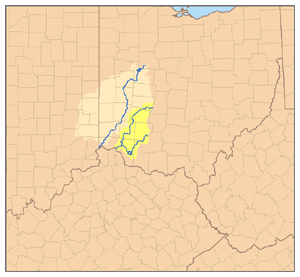
Back نهر ميامي العظيم ARZ Майами-Ривер CV Great Miami River German Miami (joki) Finnish Great Miami French Грейт-Майами-Ривер Russian Great Miami River Swedish 大迈阿密河 Chinese
| Great Miami River | |
|---|---|
 The Great Miami River near Vandalia | |
| Location | |
| Country | United States |
| State | Ohio, Indiana |
| Counties | Logan, Shelby, Miami, Montgomery, Warren, Butler, Hamilton in Ohio; Dearborn in Indiana |
| Physical characteristics | |
| Source | |
| • location | Indian Lake, Russells Point, Logan County, Ohio |
| • coordinates | 40°28′04″N 83°52′33″W / 40.46778°N 83.87583°W[1] |
| • elevation | 998 ft (304 m) |
| Mouth | |
• location | Ohio River, Miami Township, Hamilton County, Ohio |
• coordinates | 39°06′31″N 84°48′52″W / 39.10861°N 84.81444°W[1] |
• elevation | 449 feet (137 m)[1] |
| Length | 170 miles (270 km) |
| Basin size | 5,373 sq mi (13,920 km2) |
| Discharge | |
| • average | 5,368 cu ft/s (152.0 m3/s) |

The Great Miami River (also called the Miami River) (Shawnee: Msimiyamithiipi[2]) is a tributary of the Ohio River, approximately 160 miles (260 km) long,[3] in southwestern Ohio and Indiana in the United States. The Great Miami originates at the man-made Indian Lake and flows south through the cities of Sidney, Piqua, Troy, Dayton, Middletown and Hamilton.
The river is named for the Miami, an Algonquian-speaking Native American people who lived in the region during the early days of European settlement.[4] They were forced to relocate to the west to escape pressure from European-American settlers.
The region surrounding the Great Miami River is known as the Miami Valley. This term is used in the upper portions of the valley as a moniker for the economic-cultural region centered primarily on the Greater Dayton area. As the lower portions of the Miami Valley fall under the influence of Cincinnati and the Ohio River Valley, residents of the lower area do not identify with the Miami in the same way.
- ^ a b c U.S. Geological Survey Geographic Names Information System: Great Miami River
- ^ "Shawnees Webpage". Shawnee's Reservation. 1997. Archived from the original on 2013-05-02. Retrieved 2013-04-26.
- ^ U.S. Geological Survey. National Hydrography Dataset high-resolution flowline data. The National Map Archived 2012-03-29 at the Wayback Machine, accessed May 19, 2011
- ^ Gannett, Henry (1905). The Origin of Certain Place Names in the United States. U.S. Government Printing Office. p. 207.
© MMXXIII Rich X Search. We shall prevail. All rights reserved. Rich X Search